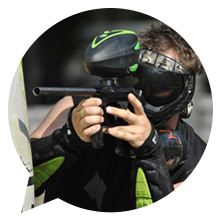Paintballing

Introduction
Also known as war games were first introduced into the UK in 1984. Since its introduction it has developed as a popular past time with approximately one million UK participants, and is now a European competitor sport.
This activity, while adrenaline pumping can also be a source of injury if reasonable precautions are not undertaken. This information sheet provides introductory guidance for operators as to their responsibilities towards staff and players to reduce the risk of serious injury. It is meant as guide for readers towards the UKPSF Code of Practice.
Safety issues
In 2002 there were an estimated 923 victims who attended Accident and Emergency Departments in the UK after an accident during participation in paintball skirmish.
The main injuries occurred to the to the leg/knee/ankle/foot, this was around 47% of victims, with a UK national estimate of 431. Strains and fractures account for 42% of victims attending accident and emergency, with a national estimate of 390 for the year 2002. A significant, though not so high number of injuries occur to the hand and arms.
Males account for just over 80% of victims. American research showed that the most common body part injured in paintball is the eye. It also showed that the vast majority of eye injury victims were not wearing protection such as a facemask or goggles.
Guidance for operators
Eye injuries can easily be avoided if a strict code of practice regarding the wearing of masks/goggles is followed. The most likely injuries include:
- Slips/trips/falls
- Impact injuries
- Over exertion/fatigue
- Sprains/strains/fractures
- Dehydration
- Cuts/Grazes
UKPSF Code of Practice
The United Kingdom Paintball Sports Federation (UKPSF) was previously known as the European Paintball Sports Federation (EPSF). The EPSF was established to promote the sports best practice and to create an encouraging outlook to those who were trying to portray it in a negative capacity. This included the intervention of the sport possibly being banned through a rewording of the Firearms Act in 1990. The organisation has developed a recognised 'Code of Practice' and an accredited venue scheme.
The UKPSF provides a membership for paintball providers who abide by the UKPSF Code of Practice and have certain criteria to meet. Members can be investigated by the UKPSF if the public report them. Site investigations can be undertaken allowing a member to become a 'UKPSF Accredited Venue', after a member passes a "rigorous site accreditation scheme". Sites that meet this criteria can be found listed on the UKPSF website.
Legislation
Under the Health and Safety at Work Act 1974 (HSWA) an employer has a duty of care to their employees and non-employees. As a workplace there is an obligation to undertake an assessment of the risks.
Occupiers Liability is particularly onerous regarding children.
Risk assessment
Risk assessment of the area – the UKPSF's Code of Practice states that the area must be free from potential hazards, as far as is reasonable practicable. Hazards have to be clearly marked and pointed out to players in a safety talk before they begin. Issues that may need some thought may include:
- The area/terrain: water, cliffs, sharp drops Stability of any buildings/structures on site
- The users: age, ability, supervision
- Noise levels
- The equipment: meeting legal requirements, maintenance Accessibility of play area by general public
- Environmental impact
- Public liability insurance is essential
Links and further information